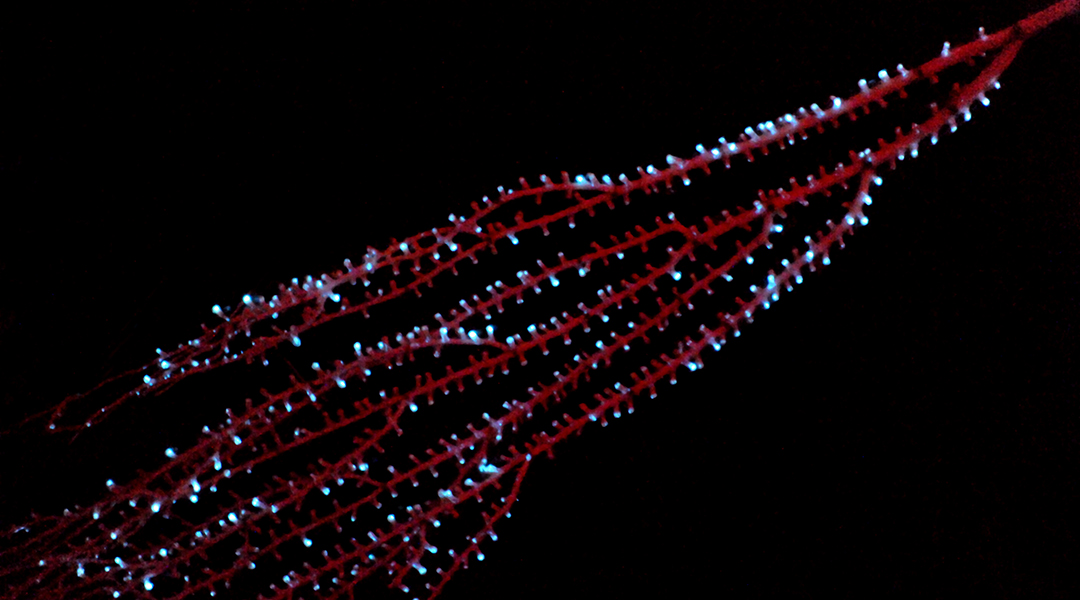Bioluminescence — an organism’s ability to emit visible light — first evolved on earth 540 million years ago in a group of marine invertebrates. These findings push back the previously established evolutionary timeline for the phenomenon by nearly 300 million years.
“Our findings support bioluminescence, and light signaling in general, as one of the earliest forms of communication on earth,” said Andrea Quattrini, a researcher and the curator of corals at the Smithsonian’s National Museum of Natural History (NMNH), in an email to Advanced Science News.
“Because this trait is commonly found in deep-water corals, the ability to bioluminesce likely enabled successful diversification throughout the sunlight-limited deep sea.”
A common thread
Bioluminescence, created by a chemical reaction, can be used to find or attract food, mates, or avoid predatory attacks. The spectacle has been observed in several hundred species many of which are marine.
While in numerous cases bioluminescence has been conserved and passed down through related species, it has also evolved independently more than a 100 times. But why this ability has evolved time and again, and when it first appeared, has been foggy to say the least.
Its persistence, however, in species through millions of years implies it was a key trait for survival. Previous research had dated the first appearance of this trait to 267 million years ago in seed shrimp.
Quattrini and Danielle DeLeo, also a researcher at NMNH, and their colleagues focused their study on the emergence of bioluminescence in octocorals. Many species of octocorals, an ancient group including soft corals, sea pens, and sea fans, have been found to be bioluminescent.
In 2022, Quattrini and Catherine McFadden, a researcher at Harvey Mudd College and an author on the new study, had previously developed a detailed phylogenetic tree of octocorals, including 185 coral species.
This tree predicts evolutionary connections between species on the basis of genetic information. By using two octocoral fossils whose ages were known as timestamps, DeLeo and Quattrini were able to infer the evolutionary timeline of other octocorals in the phylogenetic tree.
An important evolutionary trait
The researchers used extant bioluminescent species of octocorals as a starting point to work their way back up the evolutionary tree. “After that, we were able to use statistical probabilities and modeling of the presence or absence of bioluminescence to predict across time whether coral ancestors had a high probability of being bioluminescent,” said DeLeo.
While doing so, the team traced the origin of bioluminescence to 540 million years ago. “It turns out the ancestor to all octocorals was bioluminescent,” added DeLeo.
Researchers still do not know why bioluminescence came to be. Given the prevalence of bioluminescence in octocorals, it likely offered the creatures an evolutionary advantage. One speculatory theory suggests it was a byproduct of an ancient mechanism meant to protect cells from oxidation.
Over time, “bioluminescent reactions were retained because bioluminescence serves as an important form of signaling and communication, offering certain animals a survival or fitness advantage,” said DeLeo.
As bioluminescence evolved in the Cambrian period that lasted from 538.8 million years ago to 485.4 million years ago, so too did complementary organisms capable of detecting light. “Thus, our research hints at the possibility that interactions involving light occurred between species during a time when animals were rapidly diversifying and occupying new niches,” added DeLeo.
At the moment, many marine species that are bioluminescent remain undiscovered. Quattrini’s team hopes to change that as they work on developing a genetic test for bioluminiscence. “This will enable easier and less invasive investigations of bioluminescence in harder to access environments, like the deep sea,” said DeLeo.
Reference: Danielle M. DeLeo, et al., Evolution of bioluminescence in Anthozoa with emphasis on Octocorallia, Proceedings of the Royal Society B Biological Sciences (2024). DOI: 10.1098/rspb.2023.2626
Feature image: The bamboo octocoral Isidella sp. displaying bioluminescence in the Bahamas in 2009. Credit: Sönke Johnsen

















